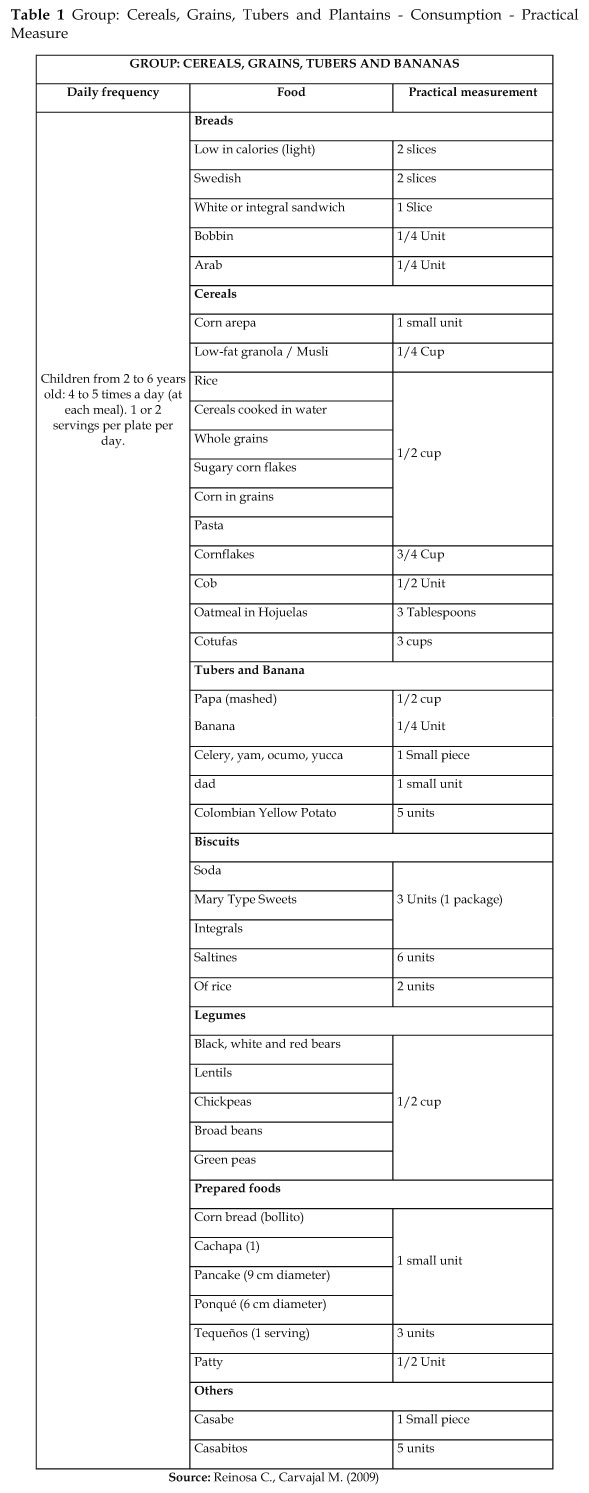
doi.org/10.15178/va.2017.141.1-38
RESEARCH
ANALYSIS OF DIET CONSUMED BY CHILDREN IN EARLY EDUCATION IN THE DAILY ROUTINE
ANÁLISIS DE LA DIETA CONSUMIDA POR NIÑOS Y NIÑAS EN EDUCACIÓN INICIAL DURANTE LA RUTINA DIARIA
ANALISES DA DIETA CONSUMIDA PELAS CRIANÇAS NA EDUCAÇÃO INICIAL DURANTE A ROTINA DIÁRIA
Adela-Carolina González-Bavera1 Bachelor in Education graduated from the Metropolitan University
Pedro-Andrés Certad-Villarroel1 Bachelor of Education, Specialist in Technology, Learning and Knowledge from the Metropolitan University, PhD in Education from the Central University of Venezuela, Coordinator for Cross-Sectional Development of Generic Competences at the Metropolitan University. https://www.researchgate.net/profile/Pedro_Certad
1Metropolitan University. Venezuela
ABSTRACT
The study aimed to analyze the results from the exploration of the diet consumed by children aged 3 to 6 years and the balanced diet recommended for preschoolers according to the National Institute of Nutrition (NIN). It is based on the foundations of Child Nutrition in accordance with the level of Venezuelan Initial Education, nutritional indications of the INN, Piaget’s Psychogenetic Theory and its relationship with nutrition for the preoperational stage. The study is descriptive, based on a cross-sectional study of representative samples based on the type of field research. Its design is non-experimental, cross-sectional with an intentional or non-probabilistic sample composed of children in early childhood education aged 3 to 6 years old, preschool students who are not enrolled in the internal food service. The sample was approached through estimating scale instruments, anecdotal record and note taking, the following findings being obtained: consumption of the Group of Vegetable Fats and Oils represented by “fried-food”-type cooking food and the Sugar, Honey and Sugarloaf Group represented by “candy”-type food predominated in the diet of students in a pronounced way in relation to the other observed food groups which were registered among the parameters recommended by the theoretical sources.
KEYWORDS: School nutrition, early education, Healthy Lunchboxes, Piaget, Nutrition
RESUMEN
El estudio tuvo como objetivo analizar los resultados encontrados a partir de la exploración de la dieta que consumen los niños de 3 a 6 años y la dieta balanceada recomendada para un niño en edad preescolar según el Instituto Nacional de Nutrición (INN). Se fundamenta en las bases de la Nutrición Infantil en concordancia con el nivel de Educación Inicial venezolana, las indicaciones nutricionales del INN, la Teoría Psicogenética de Piaget y su relación con la nutrición para la etapa preoperacional. El estudio es de tipo descriptivo, basado en un estudio transversal de muestras representativas con fundamento en el tipo de investigación de campo. En su diseño es no experimental, transeccional con una muestra intencional o no probabilística conformada por niños y niñas de educación inicial entre 3 y 6 años de edad, cursantes del Preescolar y que no están inscritos en el servicio interno de alimentación. Se abordó la muestra a través de instrumentos de escala de estimación, registro anecdótico y toma de notas obteniendo los siguientes hallazgos: el consumo del Grupo de Grasas y Aceites Vegetales representado por alimentos de tipo de cocción “fritura” y el Grupo de Azúcar, Miel y Papelón representados por alimentos de tipo “golosina”, predominaron en la dieta de los estudiantes de una manera pronunciada en relación a los otros grupos de alimentos observados los cuales se registraron entre los parámetros recomendados por las fuentes teóricas.
PALABRAS CLAVE: Nutrición escolar, Educación Inicial, Loncheras Saludables, Piaget, Nutrición.
RESUMO
O estudo teve como objetivo analisar os resultados encontrados a partir da exploração da dieta que consomem as crianças de 3 a 6 anos, e a dieta balanceada recomendada para uma criança de idade pré-escolar, segundo o Instituto Nacional de Nutrição (INN). Fundamenta-se na base da Nutrição Infantil em concordância com o nível de Educação Inicial venezuelana, as indicações nutricionais do INN, a Teoria Psicogênica de Piaget e sua relação com a nutrição para a etapa pré – operacional. O estudo é do tipo descritivo, baseado num estudo transversal de mostras representativas com fundamento no tipo de investigação de campo. Em seu desenho é não experimental transversal com uma mostra intencional ou não probabilística, formada por crianças de educação inicial entre 3 a 6 anos de idade, cursando o pré escolar e que não estão inscritos no serviço interno de alimentação. A mostra foi abordada através de instrumentos de escala de estimação, registro anedótico e anotações obtendo os seguintes resultados: o consumo do Grupo de Gorduras e azeites vegetais representado pelos alimentos fritos e o Grupo de açúcar, Mel e Papelão representados pelos alimentos tipo guloseima, predominaram na dieta dos estudantes de uma maneira pronunciada em relação a outros grupos de alimentos observados nos quais se registraram entre os parâmetros recomendados pelas fontes teóricas.
PALAVRAS CHAVE: Nutrição escolar, Educação Inicial, Lancheira saudáveis, Piaget, Nutrição
Received: 11/05/2017
Accepted: 10/09/2017
Published: 15/12/2017
Correspondence: Adela Carolina González Bavera. carogb8@gmail.com
Pedro Andrés Certad Villarroel. pcertad@unimet.edu.ve
How to cite the article
González Bavera, A. C., Certad Villarroel, P. A. (2017). Analysis of diet consumed by children in early education in the daily routine [Análisis de la dieta consumida por niños y niñas en educación inicial durante la rutina diaria].
Vivat Academia. Revista de Comunicación, 141, 1-38
doi http://doi.org/10.15178/va.2017.141.1-38
Recuperado de http://www.vivatacademia.net/index.php/vivat/article/view/1031
1. INTRODUCTION
According to the World Health Organization (2015), malnutrition is present in more than half of the deaths of children. The term malnutrition is defined by the Royal Spanish Academy (RAE, 2015), as a “condition caused by an inadequate or poor diet, or by a defect in the metabolism of food”. On the other hand, it should be noted that malnutrition can be either excess or deficit in proportion to the energy the child spends.
Deficit malnutrition is known as lack of nutrients necessary for a healthy diet. However, most of the time, lack of access to various food is not the main cause of malnutrition; since the defective methods of feeding also contribute to it. (Danielle, 2006)
In excess malnutrition, however, overweight and obesity are located. Overweight can be generally defined as excessive weight according to the expected parameter for one’s age, so highlighting the risk of obesity (RAE, Ob. cit). The World Health Organization (nd) considers obesity as “an abnormal or excessive accumulation of fat that can be harmful to health”. Furthermore, Danielle (Ob.cit.) conceptualized obesity as “... a disease characterized by increased body fat, usually accompanied by weight gain” (p. 11) it occurs when somebody ingests more calories than what he really needs and spends, generating a surplus that ends up accumulating as fat in the body, affecting the cognitive, social and emotional area. (Danielle, Ob.cit)
Hassink, S. (2007) states that “the evolution of obesity in childhood and adolescence is a complex interaction between the genetic load and the environment, the child’s temperament, raising styles, family dynamics, school and the community.” Most children are influenced by role models of their parents, the different publications of social networks, television, among others. It is for this reason that children deserve special attention in the food aspect during this stage of life, since it is during childhood that prevention of nutritional alterations is possible with a view to adolescence.
The World Health Organization (Ob.cit.) noted that, in 2013, more than 42 millions of children under five years old were overweight. In 2014, more than 1,900 millions of adults aged 18 or over were overweight, out of which more than 600 millions were obese. Similarly, on that same date, around 13% of the world’s adult population (11% of men and 15% of women) was obese; 39% of adults aged 18 or older (38% of men and 40% of women) were overweight. Therefore, the global prevalence of obesity has more than doubled from 1980 to 2014; highlighting that “Childhood obesity is one of the more severe public health problems of the 21st century.”
Maybe one of the aspects that represses caloric expenditure in children is currently focused on technological advances. Without losing sight that there are many benefits that can be constantly enjoyed, the physical efforts that are made are less and the available tools are more; affecting in such a way the health of both children and adults. According to Olivares (2000)
“Several studies that address the relationship among television, eating styles and the increase in overweight and obesity since the first years of life have shown that the time spent by children to watch television determines a decrease in their physical activity, a lower basal energy expenditure and a greater consumption of high-energy-density food that have a high content of total fat, saturated fat, sugar and salt, all of them being risk factors not only of overweight and obesity ... “(p.268)
Similarly, it is worth noting that the accelerated life constantly carried out in various cities has led a large number of individuals to consume food outside home, which are mostly fast food establishments or ready-to-eat products with a high energy load. According to Canvi (2005) “Due to the haste, the daily hustle and modern stress, many people find it desirable to feed on certain fast “food”. The problem with this is that they are daily consuming elements that do not provide the correct nutrients to their body” (page 31)
In Spain, in the working group on obesity in childhood and adolescence composed of doctors Tojo and Leis (2007), they published in the book of Strategy NAOS an updated study of the determinants of obesity in childhood and adolescence.
“The authors agree in identifying the obesogenic risk in a toxic environment, like the one surrounding the adult population: a widest supply of non-natural (manufactured) food with high energy content (fat, refined sugar, low nutritional quality, excess salt) very tasty and attractive to the palate. And also, greater hedonic power than, in the order of greater to lesser: fat, carbohydrates, proteins and inversely in their satiating power. “Goodies” and soft drinks are two typical examples. In children and adolescents, these eating habits, to a greater extent than in adults, are favored by the continuous “blitz” on television, radio and other media; in the accessibility to those foods in the market and in general in the consumer pressure to which they are more vulnerable”. (p.99)
Kliskberg B. (2000) cp Naranjo, C., Nahr, E., Muñoz, N. and González, W. (2004) stressed that malnutrition is one of the great problems confronting most Latin American countries and other regions of the world (page 5), which may lead one to believe that nutrition is not being adequately addressed in the context of the Latin American child.
Barría M. and Amigo H. (2006) state:
“The increase in excess weight may be one of the results of globalization, probably due to the increasing importation of food from the industrialized world and the fall in prices. This way, the greater availability of non-traditional food has caused a change in the consumption patterns of the countries, demonstrating a greater supply of fats and oils at low cost that have determined an increase in their intake. “(P.16)
Perdomo and Mendoza (2006) point out that Venezuela does not escape this reality, since the beginning of the 1990s, overweight and obesity have been a risk factor in the five leading causes of death. Similarly, they emphasize that overweight and obesity have increased in recent years in earlier ages. Chavez, M. (s / f), a specialist in child nutrition in Venezuela, in digital publications of the National Institute of Nutrition (NIN), stressed that “There is talk that, out of every ten children, three are obese. This indicates that, in the future, our society will be obese. “
Similarly, Perdomo and Mendoza (Ob.cit.) refer to the fact that both obesity and overweight are rooted in the culture, the globally made political and economic decisions and society. Likewise, they emphasize that these diseases are directly associated with the feeding process; therefore, availability, access to them and their cultural implications play a very important role. Thence the importance of incorporating the physical activity in daily life; otherwise, a sedentary lifestyle is nourished, which has a special relationship with these diseases.
Circumstantially, by the time that this piece of research is carried out in Venezuela, there is a decreased availability of food accompanied by an economy with an inflationary trend. In the forum “Global food crisis and its impact on Venezuela” delivered at the Metropolitan University, they highlight that there are diverse opinions and studies of the fundamental causes of this crisis; the following are among them: “climate change and natural accidents, increasing population, decreasing inventories of fishing, the decline in the availability of fresh and drinking water, the soaring prices of fertilizers and transportation costs, financial speculation ... “, the truth is that there is a varied inventory in supermarkets and the Venezuelan must often acquire what it is available and not what he should or wants. This circumstantial problem has an impact on this piece of research, since it is pertinent to educate the population on how to combine the existing food without compromising the diet recommended by the INN for the Venezuelan. It should be noted that, although this is not the core of this study, it has been taken into account, as mentioned above, due to the circumstance.
Perdomo and Mendoza (Ob.cit) continue to highlight:
“This pathology has been considered since the late twentieth century as a public health problem with a dimension of epidemic, which now not only has a high prevalence in developed countries but is also emerging in countries in transition, where obesity and malnutrition coexist; however, obesity may be preventable as long as appropriate changes are incorporated in the lifestyle.” (p 27)
Framing what has been described above in education, the first stage in the formal education of the human being is early education, which can range from zero to six years old. It is a stage in which various changes occur in the child related to their growth and habits as well as to their maturation, involving the physical, socio-emotional, cognitive and motor aspects.
In this stage, balanced nutrition in children, in addition to influencing their size and weight as part of their physical appearance, is essential for the establishment of their future eating habits, helping them to prevent alterations in view of integral optimal development which involves educational aspects enhancing attention, memory, interest, readiness and performance, among others. According to Barone and Suarez (2003) “The human being acquires energy (calories) and nutrients (sugar, fat, protein, vitamins, minerals and water) when consuming food” (p.98) and, hence the importance of these nutrients in a balanced diet that provides the child and the girl with the necessary energy according to their age.
In the Venezuelan context, the early education curriculum (2005) describes some characteristics of the child aged three to six years concerning food: “At this stage, maturation of functions, body control and development of cognitive social skills are more important. They improve fine and gross motor coordination and advance in language development.” (p.362)
Both parents and teachers as well as caregivers who are in charge of feeding the child should pay special attention to this aspect and constantly promote the importance of nutrition in the child’s development to bludgeon, to some extent, the problems described above.
Given this, then a big challenge is posed because children are exposed to a significant amount of pre-packaged and ready-to-eat food that is more accessible and does not create complications for its preparation as compared to unprocessed food that, though it is true that they are healthier because they have less preservatives, their preparation takes longer. Similarly, it is expedient to buy packaged juices, energy-giving drinks or soft drinks. All this facilitates the presence of malnutrition.
The case-area selected for this study does not escape this situation, Preschool Elemental Workshop on Creativity located on the main avenue of Cafetal, Chuao urbanization, Baruta Municipality of Miranda State, Caracas, Venezuela, consisting of a population of approximately 346 students, children of maternal and early education, in which, during the snack time in the working day, it is possible to see the abundance of processed food, packaged juices, fried food and candies in lunchboxes. Likewise, lack of balanced food combinations allowing the child to replenish energies lost along the academic day was initially and informally recorded.
This situation draws attention because, although preschool provides a food service, only a minority of children uses it, because of it, this study only covers those children who carry lunchboxes or containers with food brought from home, excluding children feeding through food service.
From the above, the following questions arise: how is the diet contained in the lunchboxes of children aged three to six years in the preschool field of study, What are the recommendations of the INN for the diet of a child aged 3 to 6 years old at school?, finally, what is the balance of the content of the lunchboxes of children in the preschool field of study?
2. OBJECTIVE OF THE STUDY
Analyze the results of the exploration of the diet consumed by children aged 3 to 6 years not enrolled in the food service and the balanced diet that a preschooler should consume according to the National Institute of Nutrition (INN).
3. APPROACH AND METHOD
The approach is divided into two parts: the Pedagogical Foundation and Nutritional Foundation.
3.1. Pedagogical Foundation
The pedagogical foundation is divided into three parts. It begins with Early Education, then with the Development of the child and culminates with the characteristics of the pre-operational child
3.1.1. Early Education
Over the years, there have been various concepts of education; however, all of them range from ideas that it is an activity or a permanent process that occurs throughout life, involves all ages, the different contexts, whether general or specific, are taken into account, both the child’s own potentialities and those of the environment develop in order to seek growth, happiness and well-being. The subjects being part of education are the family, the school, the community, among others.
The Early Education Curriculum (2005) establishes Early Education “as a stage of comprehensive care for children, from their conception until being aged 6, when entering the first grade of elementary school. It consists of two levels: maternal and preschool “(p 19).
The maternal level refers to the education of children from pregnancy to age three. The preschool level is focused on children aged three to six years. During this stage, many changes, both in the emotional link and in development, occur; the brain and its neuronal interconnections grow, there are several significant changes at motor level, language, among others, highlighting that, for the optimal development of all individuals, the intake of a balanced diet that provides all the necessary elements in quality and quantity covers a fundamental aspect, especially during the first years of life.
During preschool, both parents and teachers should pay close attention to the food for their children, teach its importance and thus train them in the prevention of various risk factors. Garcia and Golding (2009) highlight “it is easier to establish good food habits early than to try to change bad habits in adolescence or in adulthood” (page 300)
One of the main foods that can be evidenced in preschool children is breakfast or snack, in some cases, at the beginning of the day or midmorning; which is known as the lunchbox. As it is one of the main meals, parents should pay more attention to both the quantity and quality of food present in said lunchbox and, thus, be able to meet the energy needs of the child.
Garcia and Golding (Ob.cit), made some recommendations for the preschool lunchbox:
– The food should be kept in simple preparations and be previously known by the child, then go changing it.
– Freeze the natural juices the night before so that they are at a comfortable temperature and in good condition at the time the child consumes them.
– Parents should talk to the child about the contents of the lunchbox and the child’s preferences.
– The outer packaging must be lightweight and made of a material that protects the content of water from dust and avoids the deterioration of the food.
– Food containers must be made of materials being resistant and easy to open by the child.
– The food should preferably be natural.
– Remove from the lunch box the tidbits, soft drinks, among others.
– The preparation of the food should be varied in flavors, colors and textures, in the right amount for each child.
– The portions must be of a manageable size to prevent the child from rejecting them.
– Once the child arrives at home, parents have to check the lunchbox, wash it and leave it open until the next day.
– When there are leftovers, it is important to talk with the child to know the cause of their rejection.
Similarly, these authors give several tips to be considered when introducing new food into one’s child’s diet:
– New food is better accepted if offered when the child is hungry and one must remember that the child can throw the food away the first few times he tries it.
– For a child to accept new food, he must repeatedly be exposed to that food or to the food he rejects consciously, from eight to ten times, although this might take more time than what parents are willing to endure.
– The combination of the preferred food with the less accepted increases the variety of the diet and the acceptability of the preparations.
– Preschoolers respond better if given to choose some foods (approximately two) than if they are asked what to eat.
– Avoiding ingestion of large amounts of liquids (juices, soft drinks, water) before meals prevents the decrease in the child’s functional gastric capacity.
– The child’s curiosity allows parents to introduce new food and using different colors, flavors and textures.
– Children who participate in shopping activities, selection, preparation of food and in serving food develop a better relationship with food.
– It is not recommended to completely eliminate food with low nutritional percentage and, much less, to ban it. Such behavior would lead to creating an obsession with this type of food, which can result in the child cheating to get it. The child should learn that any food consumed in moderation can be part of a healthy meal plan.
3.1.2. Child development
Over the years, each theoretician has defined the term development differently, focusing on various aspects of development and highlighting some causal factors. However, according to Meece (2000), the majority agrees that “development represents successive systematic changes that improve the overall adaptation of the child to the environment” (p. 16).
In early childhood, there are several noticeable changes in terms of physical development. From the age of three years or so on, children gradually acquire a leaner and more athletic look, abdominal muscles develop, the trunk, the arms and legs stretch, the body proportions become more like those of adults, among others.
At the age of three to six years, the muscular and skeletal development progresses and children get stronger. Similarly, the cartilages and bones become denser, thus creating a firmer appearance in the child and protecting the internal organs. The brain and the nervous system are maturing so a great diversity of motor skills develops. On the other hand, there is a growing capacity of the respiratory, circulating and immune system, which consolidates fitness and keeps children healthy.
From three years on, the average height varies around 92 cm and the child’s approximate weight is 15 kg. During this stage, the child’s height increases from 5 to 7.5 cm and his weight increases from 2 to 3 kg every year. Similarly, it should be noted that, when growth slows down, the child requires fewer calories per kilo of weight and vice versa.
At the age of three, all the milk teeth have appeared and, from six years on, the permanent denture begins to develop. In this stage, a problem quite frequently occurs in most children: tooth decays. This condition, most of the time, is usually the result of excessive consumption of milk, sweetened juices, candies, among others; along with the absence of regular dental care.
During these ages, children make great advances in their gross motor skills; because their bones and muscles are stronger and their lung capacity increases and allows them to run, jump, climb longer distances and at a higher speed.
During the preschool stage, there is some stability in growth; Garcia and Golding (2009) argue that it occurs “due to a decrease in the rate of height and weight that determines a decrease in appetite; therefore, these children need fewer calories per kilo of weight to meet their daily caloric requirements ... “(p.295). Therefore, their appetite during the day is irregular and it may vary depending on the day.
Thanks to the neurological maturation children have developed over time, they can know freely the world around them, look for food alone, communicate acceptance or rejection of a specific food, they can eat alone, use the cutlery as well as glasses and cups in a quite appropriate way and, at the end of this stage, they gradually manage to use the knife.
3.1.3. Characteristics of the pre-operational child
The Biological Theories of development mean that the child goes through invariable and predictable stages of development. These theories have served to explain the changes in stature, language, weight, motor and mental skills, among others. The Psychoanalytic Theories are based on the evolutionary changes of oneself and personality. It will be affected depending on the ways in which the child meets their needs at different ages. Behavioral theories refer to the fact that the evolutionary changes of behavior are greatly influenced by the environment, external stimuli. The Contextual Theory stresses that, as the child actively interacts with and seeks new physical and social contexts, these contexts will contribute and shape the child’s development. The Cognitive Theories assume development as the result of interaction, in a propositional way, with their environment.
One of the best known evolutionary psychologists in the field of pedagogy is Jean Piaget. According to Meece (2000) “he proposed that children go through an invariable sequence of stages, each one characterized by different ways of organizing information and interpreting the world” (p.22). During the growth of the child, there are various stages of development and they will vary depending on age. Piaget structures his theory on two key components: the model around the origin of knowledge and the model of cognitive development.
The pre-operational stage indicated by Piaget according to Gerrig J. and Zimbardo P. (2005) “The great cognitive advance in this stage of development is the ability to represent in the mind objects that are not physically present” (page 326). Similarly, there are changes in motor sensory development, language development, intellectual development and social affective development.
Pre-operational children, during social affective development, pleasure changes from the oral faction to genital pleasure, mainly by sphincter control. In the same way, they give greater importance to what other colleagues may think and care about their actions. Gispert, C. (1983) “This age is very important for the formation of the child’s personality” (p.81).
According to Mahan L. and Escott-Stump (2009), the relationship with food and nutrition in the pre-operational period from two to seven years of age is based on:
“Eating becomes less the center of attention and is secondary to social, language and cognitive growth. Food is described by color, shape and quantity, but the child only has a limited capacity to classify food into <groups> “(p. 228)
3.2. Nutritional Basis
Nutritional Foundation is distributed in fourteen sections. Their order is as follows: Food, Nutrition in Venezuela, National Institute of Nutrition, UNESCO, CENDIF, Food Groups, the Food Spinning Top, Perception of Food, Changes in Nutrition, Overweight, Obesity, Nutritional Deficit, Diet and finally the energy requirements by age.
3.2.1. Feeding
According to the author Gispert (1983b) “the substances man gets into his body to maintain biological constants and preserve health are called food” (p. 108). On the other hand, the authors Barone and Suárez (2003) point out that “nutrients are chemical compounds that satisfy the needs of matter and energy required for all the functions of the body” (p.98).
That is why it is important to eat not any type of food but that which really contributes to physical, psychological and social well-being: “ It is a known fact that feeding exerts a far-reaching influence on the health and life of human beings.” (Landaeta M., 2000, p. 94). In order to guarantee an adequate and balanced diet, it is necessary to emphasize both its quality and quantity; this way, all the caloric contributions necessary for a healthy life would be covered.
During the pre-school stage, diverse changes occur in the child in an accelerated manner both in their growth and in their development. In the same way, children go through different moments and spaces of adaptation, exploration and change. It is therefore that, during this period, more attention must be paid to feeding the child, fundamentally because said habits will last for the whole life of the child. Similarly, because their nutritional requirements are greater as compared to the other stages, it helps to protect from diseases and to replace tissues that are constantly being used, among others.
Most of the time, the act of feeding is not given the importance it deserves and it is usually reduced to concern for the child to eat by satisfying their needs and preferences, without paying attention to the caloric contribution of said food, its nutritional value, and leaving aside the requirements of their personal development. Similarly, according to Vázquez, De Cos and López-Nomdedeu (2005), the genetic factors undoubtedly influence the choice of food, but the processes of observation and imitation seem to be of greater importance, in such a way that the child tends to eat what he sees the adults around him and his own companions eat.
The authors Posada, Gómez and Ramírez (2005) emphasize that the child “needs to have five meals a day, distributed in breakfast, morning snack, lunch, afternoon snack and dinner” (p. 222) The main meals should be complete and should include the various food groups to provide the child with all the necessary nutrients and allow him to carry out his activities. Mahan and Escott-Stump (2009) highlighted that “snacks are just as important as meals because they contribute to the total daily intake of nutrients.” (p 232) Similarly, it is appropriate to use creativity and imagination in the different kinds of food to arouse motivation and interest in the child to try new food; as well as highlighting the various properties food contains and how crucial it is for the child to grow up healthy and strong.
The National Institute of Nutrition (1982), established several recommendations for child feeding, emphasizing that the child should eat in a quiet, pleasant environment and surrounded by some care and affection. Children should not be offered prizes neither should they be punished for not eating or rejecting food. In the presence of a child with no appetite, the problem of lack of appetite should not be discussed in his presence. It is important that children eat but it is even more important that they feel comfortable and relaxed during meals. It is extremely important to vary the presentation and taste of food. Physical exercise stimulates appetite so it is recommended to run, jump, play, etc. Avoid, if possible, giving children excessive sweets: ice cream, candy, soft drinks, etc. Finally, prepare food in a simple and enjoyable way, always maintaining hygiene.
As noted above, in said step the family plays a role of great importance. However, the process of consolidation of dietary habits cannot neglect the educational factors, highlighting the importance of the role of schools and teachers in it.
The preschool educator, in addition to influencing the academic part and training, doing activities where different food groups, are involved snacks with various food groups in which students can try them while stressing the importance of each of them, mention the benefits when consuming each of the different groups, making healthy recipes, among others. Similarly, the preschool educator has some responsibility for the development and growth of the child. A child with an adequate nutritional status will grow harmonically, actively participate in classes, meet the standards expected at different stages of childhood and academic development, maintain adequate development, easily endure the diseases which preschool children must constantly go through, and teachers, as they are constantly in contact with children, can notice everything outlined above and promote both the development and growth of children.
3.2.2. Nutrition in Venezuela
The author Fishbein (1967) noted that nutrition is “the sum of the processes involved in growth, repair and maintenance of the full body” (p. 528). Today in Venezuela there are several institutions and centers focused on providing the tools necessary for optimal development of children; whether in culture, education, health, among others.
At the United Nations Millennium Summit held in September 2000, various objectives and goals were raised in order to make a global program where poverty, disease, famine, environmental degradation, illiteracy and discrimination against women are tackled. From it, a food policy was made in Venezuela linked to the Goal of the Millennium and based on the “eradication of extreme poverty and hunger”. According to Osorio and Di Luca (2014), that goal is evaluated based on the goal “to halve, from 1990 to 2015, the proportion of hungry people.” This goal is supported by two main indicators: “The rate of prevalence of undernourishment”, trying to make an approach to the number of approximate people suffering from hunger in a country and “ Prevalence of Global Nutritional Deficit in children under 5 Years (weight/age indicator).”
According to the National Institute of Nutrition (2008):
“The nutritional situation in Venezuela for children is favorable. According to the parameters established by the World Health Organization (WHO), they indicate that nutritional deficiency in children under 5 years in 2007 is low ... The rate of undernourishment in 2006 is 6%, which implies a reduction of 15 percentage points as compared to 1998 (21%). It can be said, then, that the country has practically met the Goal of the Millennium of hunger reduction scheduled for 2015”.
The United Nations Food and Agriculture Organization argues that food security policies are always appropriate as long as the supply of food energy reaches or exceeds the value of 2,720 calories per person. By 2009, according to these references raised by FAO, Venezuela is considered a country with Food Safety. Similarly, according to the latest data reported for the year 2013, this indicator increased by 3,108 calories per person. Osorio and Di Luca (Ob.cit ), highlight:
“The latest reported value of the indicator of the Rate of Prevalence of Undernourishment (IPS) is for 2011-2013, when it stood at less than 5%,, reaching a value of less than half the number existing in 1990. It is important to highlight that the highest value of all the historical series was recorded in 1998, which stood at 21 %,; this value, compared to the current figure, represents a reduction of 92.4% (almost 5,000,000 people). Had the political socioeconomic policies implemented in the 90s been maintained, according to statistical projections, now there would be 12,781,027 of people suffering from hunger, more than 44% of the current population” (p. 22)
Among the main food consumed in these meals, in the first group due to their contribution in fiber, vitamins and minerals, there are: bananas, roots and tubers, as well as pre-cooked corn flour, pasta, bread and rice. Next come fruits. Similarly, there is a high consumption of chicken, beef, eggs, fluid milk and white cheese in the group of dairy, meat and eggs. In the group of fats: vegetable oil and, in the sugar group: table sugar, sparkling drinks and pasteurized juice.
Food Safety policies in Venezuela refer to the component of biological use of food, using such indicators that assess the nutritional status of the population and the advances in this field. Through it, as stated by Osorio and Di Luca , a “marked decline in infant mortality due to malnutrition in children under 1 year, reduced from 116.7 deaths per 100,000 recorded live births (year 1996) to 17.1 deaths in 2011, the latest data available.” (p. 39). Similarly, they refer to the nutritional status of children under five years, which include the reduction of their malnutrition, standing at 3.37% in 2013. However, in terms of malnutrition for excess, for that year the numbers increased, reaching 4.0% in children under five.
3.2.3. Food Groups
According to Fishbein (1967) “nutrients needed by the body can be classified into five major groups: proteins, carbohydrates, fats, vitamins and minerals” (529 p.).
Proteins are composed of hydrogen, carbon, oxygen and nitrogen. They represent from 13% to 15% of body weight and provide, like sugars, 4 calories per gram. (Barone and Suarez, 2003: 100). Carbohydrates are mainly those that will provide most of the energy; however, excess of carbohydrates will accumulate as fat. Fishbein (Ob.cit.) noted that “fats provide longer and more sustained energy than carbohydrates and have a single initial lymph circulation”. (P. 530)
According to the authors Suarez and Barone (Ob.cit.), “Vitamins are complex organic compounds that are present naturally in plants and animals. They are required on a daily basis in our body in small amounts.” (P. 101). Minerals are found in large quantities in most foods. As well expressed by these authors Barone and Suarez (Ob.cit.), “minerals are inorganic compounds that regulate many processes in the body, for example, muscle contraction, and they represent 5% of body weight” (p 101).
3.2.3.1. The Food Spinning Top
The Food Spinning Top was created in 2007 by the National Institute of Nutrition, replacing the old model of the food pyramid. It classifies the 5 groups of food, water and physical activity, in order to promote growth, development and good health, so ensuring a healthy individual.
The National Institute of Nutrition, highlights on its website that the main objectives of the Food Spinning Top are: know each of the food groups, their functions and their nutritional contribution to the daily diet. Improve the eating habits of the Venezuelan population, as well as the food safety levels in terms of purchase, selection, distribution and consumption of food at home. Establish intervention measures based on public policies in favor of collective nutritional well-being. Promote the necessary measures to address the nutritional risks and deficiencies. Combat hoarding and shortages of food items nationwide. That every citizen gets the daily requirement of nutrients, raising awareness when purchasing food.
The first strip is yellow and belongs to the group “Cereals, grains, tubers and bananas”. They, which are well known as carbohydrates, are major contributors of energy and are composed of vitamins, iron and fiber. For example: Casabe, rice, cassava, banana, potato, scone, corn bread, corn, sweet potato and grains (black beans, beans).
The second green strip belongs to the group of “vegetables and fruits.” It is characterized by containing vitamins A and C, minerals, water and fiber essential for the proper functioning of our body as well as for intestinal functions. There are numerous diseases that can be prevented by this group; including obesity, hypertension, diabetes, cardiovascular diseases, colon cancer, among others. For example: Mango, pineapple, melon, watermelon, guava, banana, papaya, tangerine, orange, passion fruit, lemon, tomato, lettuce, beet, pumpkin, carrot, onion, paprika, cabbage, cauliflower, broccoli, eggplant, watercress and zucchini.
The group of “dairy, meat and eggs” belongs to the third blue strip that represents proteins, which contain minerals such as calcium and iron; vitamins A, D, B1, B2, B12. For example: milk, cheese, yogurt, chicken, fish, pork, eggs, among others.
At the right end of the spinning top is the orange group of “vegetable fats and oils”. It is necessary for the proper functioning of the body, it is a concentrated source of energy and is the transport of various vitamins. However, they must be consumed in moderation and in small quantities. Among them are: vegetable oils, margarines, avocado, among others.
At the left end is the gray group of “Sugar , Honey and sugarloaf”, with the main function of contributing quickly used energy. However, consuming them in excess can influence weight gain, potentially leading to obesity, as well as tooth decay.
Beside the spinning top is its cord represented in the form of water and accompanied by dolls performing physical activity. Through it, as expressed by the National Institute of Nutrition, they aim to stress that, without water, there is no life and likewise, without its cord, the spinning top does not dance.
Water meets several key objectives for development and for ensuring a healthy individual; it is a means of transporting nutrients and other substances from the body. It is the way par excellence to release harmful substances. It participates in the regulation of body temperature. Water is essential for the proper functioning of all our organs and systems. Similarly, physical activity should be a complement to a varied and balanced diet combining the different strips of the Food Spinning Top and incorporating daily water consumption. Its benefits include reducing the risk of obesity, cardiovascular diseases, cancer, osteoporosis, diabetes, among others. It strengthens bones and muscles. regulates fat levels and blood sugar. It regulates blood pressure. It helps reduce depression, anxiety and insomnia. It allows a sense of well being. It improves the use of energy, among others.
3.2.4. Diet
According to Montero (2003), when referring to the word diet, unwittingly it is involved in the field of health. According to the Royal Spanish Academy (2015), diet is a “set of substances ingested regularly as food.” However, according to these authors, diet should not be understood only as a set of food you eat but rather as a style of feeding that must be implemented throughout life to keep a healthy lifestyle and to obtain the nutrients needed to live.
3.2.4.1. Energy Requirements according to Age
Fayard, M (1956), highlights “the different foods, which are intended to meet the diverse needs of the by, should be supplied every day. The child grows all the time, not just on certain week days ...” (p.266). Thence the importance of meeting the minimum daily needs of each child according to various foods and nutrients according to their age. That is to say, cover the necessary daily calories divided into: proteins, calcium, iron, vitamins, carbohydrates, sugar, among others.
According to Garcia and Golding (2009), the requirements for macronutrients and micronutrients, taking as a reference the “reference values of energy and nutrients for the Venezuelan population”, the intake of various food groups should be as follows:
– Sugar or simple carbohydrates should not exceed 6% to 10% of total carbohydrates or no more than 25% of total calories in the diet, including the various sweetened beverages.
– Complex carbohydrates should cover from 45% to 65% of total daily energy.
– Fiber intake with grains, tubers, cereals, fruits and vegetables should be considered according to age “Fiber (g) = age (years) + -5”. For children aged 1 to 3 years 19 grams and for children aged 4 to 8 years 25 grams per day
– Proteins should contribute from 13% to 15% of total calories
– Fats should cover from 30% to 40% of total caloric intake
– Water intake should be from 1.3 liters per day to 1.7 liters per day
On the other hand, they emphasize that food is distributed in three main meals and two to three snacks throughout the day. The time between them should be long enough for the child to feel hungry.
Below is a table with various food groups, their daily intake and the practical measure that must be taken into account.


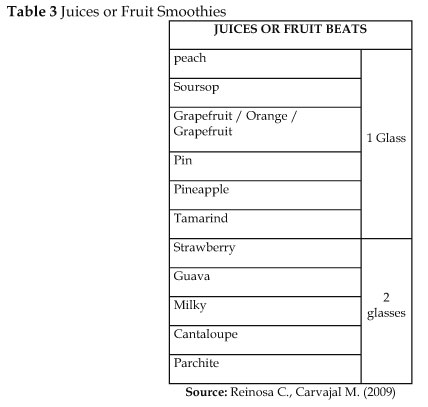
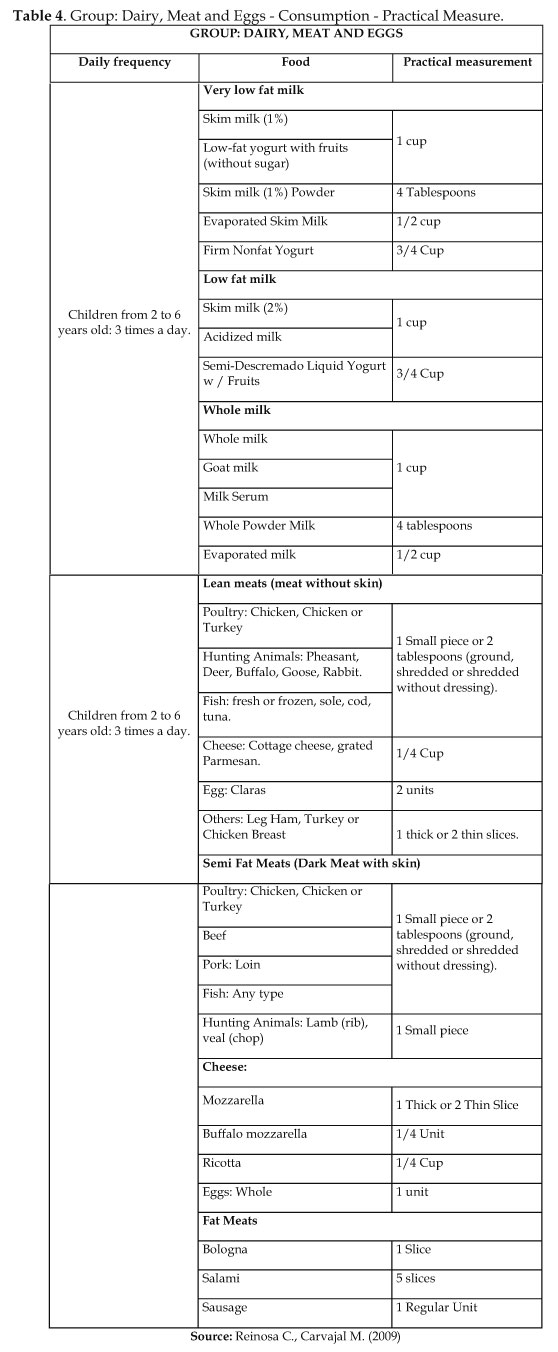
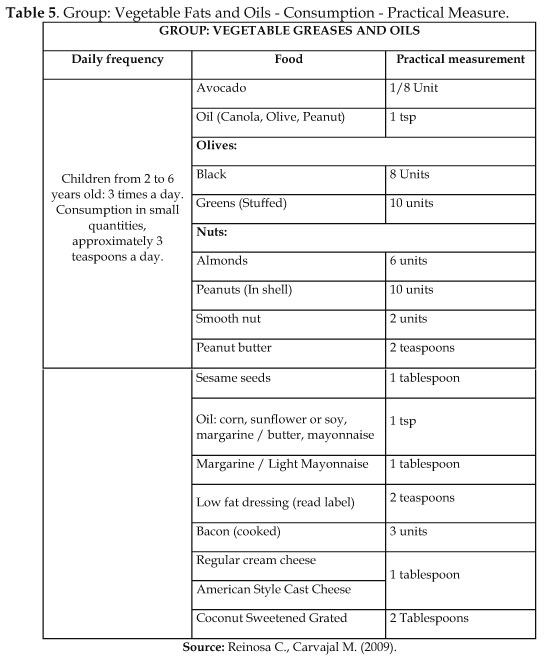
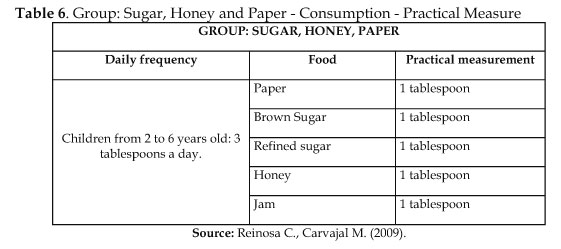
3.3. Method
The study is descriptive (Landeau, 2007), based on a cross-sectional study of representative samples based on the type of field research ( Hernández, R., Fernandez, C. Baptista, P., 2006). Its design is non-experimental, cross-sectional with an intentional or non-probabilistic sample (Toro and Parra, 2006; p.157) made up of children in early education aged 3 to 6 years old, preschool students who are not enrolled in the internal food service. The sample was addressed by estimating scale instruments, anecdotal record and note taking. ( Hernandez, R., Fernandez, C. and Baptista, P., Ob.cit)
3.3.1. Inception phase
For this phase, the goal was to explore the diet consumed by children aged 3 to 6 years not enrolled in the food service during the workday. Then we described the diet found as a result of exploration that is consumed by children aged 3 to 6 years not enrolled in the food service in the working day. For this, the instruments described as Checklist and Anecdotic Records proper to the technique described as Observation.
3.3.2. Development Phase
In this phase, the goal was to analyze the results of the exploration of the diet consumed by children aged 3 to 6 years not enrolled in the food service and the balanced diet should be consumed by a preschooler according to the National Institute of Nutrition (NIN) , and to determine, on the basis of the results obtained from the analysis, the elements the instructional design must have on how to organize a balanced diet for the feeding routines of children aged 3 to 6 years not enrolled in the food service. In this period, we used data and information obtained through the diagnostic phase and proceeded to describe the diet consumed by children aged 3 to 6 years not enrolled in the food service and the parameters set pursuant to the National Institute of Nutrition for a balanced diet. To do this, the food grouping based on the Food Spinning Top (INN) and the pattern measuring the amounts of food in the lunchboxes of children were applied. Then, based on the results of the analysis, the elements that the instructional design must have were established.
3.3.3. Final phase
Once established the elements that the instructional design must have, we developed a guide to balanced food for healthy lunchbox meals, aimed at preschoolers aged three to six years old not enrolled in the food service. Its purpose is based on providing scientific information to parents, teachers and caregivers to enable the design and development of balanced diets for snacks or breakfast aimed at preschoolers aged three and six years old not enrolled in the food service; based on the results of the analysis.
4. DISCUSSION
4.1. Exploring the diet consumed by children aged 3 to 6 years not enrolled in the food service in the working day
In this phase, we conducted a scan to observe the diet consumed by children aged 3 to 6 years not enrolled in the food service during the working day at preschool. This observation was carried out in three days: on Wednesday, Thursday and Monday during the snack schedule for the three levels (II, III and IV); through observation and anecdotic recording. The reason why three observations were chosen is based on recurring situations and not be subject to what might have been collected in only one event.
The snack schedule for each level consists of approximately thirty minutes; second level snack from 9:30 am to 10:00 am, third level snack from 10:00 am to 10:30 am and fourth level snack from 10:30 am to 11:00 am, approximately. During said schedules, children seek their lunchboxes, pray through a song and say “Bon appetit” at the end, take their tablecloths along with their food. The food children do not eat they put it again in their lunchboxes, then they collect all the packages, put them back into the lunchbox with their tablecloths and put the lunchbox back in place.
During these observations, it was noted that in general lines:
– Children regularly consume everything they are sent in the lunchbox.
– The regular hygiene standards for food consumption are not met (eg children do not wash their hands before eating). However, before sitting down at the tables and before standing up, they must be clean.
– During meal time, they interact through conversations on various topics.
– No food exchange occurs, ie, the food the boy or girl does not like is not exchanged for another with a partner who likes it.
– Sweet foods like candy or cookies are shared.
– Children first regularly eat their sandwich, corn cake, cheese pancake, praline or any food made of corn or wheat flour. Then, in the case of fruits, they continue with this food and, finally, eat the candy, cookies or sweets.
– Classroom teachers encourage students to consume all the food they bring. If they fail to do so, teachers will strive to have children consume at least half of the portion of food.
– It was frequently observed that food portions children carried were plentiful, especially with sandwiches.
4.1.1. Scan day 1 (Wednesday)
The first scan was conducted on Wednesday, April 27, 2016. We entered preschool very early in order to meet all children who are enrolled in the food service and make said observation with all those who are not enrolled. When entering preschool, all board members were already aware of the activity to be performed so they proceeded to show the several rooms, introduce each of the teachers, explain what was going to be done and show the snack schedules for the respective levels.
4.1.1.1. Second Level of Early Education
During the meal, it was observed that most children carried sandwiches with cheese, fruit and sweet cookies accompanied by water. Similarly, all through the snack, children made comparisons of their food with their classmates, for example, a student said “they gave me bread and butter” and his classmate added, “Mine also has butter”. Others showed what they had brought: “Look! It’s a Nutella bread”, “Look, this is oreo and this is yogurt”. And one was counting the sandwiches he had been sent, “my mom sent me many sandwiches 1 2 3 and 4 “.
4.1.1.2. Third Level of Early Education
At the time of the snack, we could explore its variety; predominance of the sandwich; however, we could see, pancake, fried nuggets and croissants, accompanied by water. Like II level, children made comparisons of their meals, for example, one stood out “I have muffin with cheese “ and a classmate added, “but I have two loaves of bread alone .” They also emphasized that one had water and the other orange juice. Similarly, some described what they had been sent “I’m eating chicken,” “I’m eating pancake with cheese “. On the other hand, we could see how one of the girls had a heart-shaped cheese sandwich and she told so to her classmates.
4.1.1.3. Fourth Level of Early Education
Once all the students had taken out their lunchboxes, one said: “I have a lot of sugar, lots of sugar” and the teacher said: “Cereal”. Others said: “I have fried cornmeal roll and cheese”, “pancakes with syrup and sausage”, “cheese pancake and juice and water and biscuit”. On the other hand, a student had a cookie and added: “What happens is that I ate at home”. It is therefore that, generally, we saw various food groups, such as protein, carbohydrates, sugars, fats and various accompanying drinks.
4.1.2. Scan Day 2 (Thursday)
The second scan was conducted on Thursday, April 28, 2016. We entered preschool and greeted all board members and teachers. As it was the second day, we already knew the classrooms and schedules, so we proceeded directly to make observations in the respective rooms.
4.1.2.1. Second Level of Early Education
Once all the food was on the table, students proceeded to eat. During that period, some were lopsided and watching the ceiling, commenting on the moon and sun. Similarly, they commented about what they were eating, “I’m eating chocolate bread and pear compote.” On the other hand, a student had a complete cornmeal roll with cheez whiz ® (yellow spreadable cheese) and said: “I didn’t like it”, afterwards, she put the lid on the container and proceeded to eat fruits that she had in another container. Similarly, while the observation was made, the teacher said: “He can’t eat dairy and they always send the same to him, bread and egg”.
4.1.2.2. Third Level of Early Education
Once all the children had their lunchboxes, we proceeded to say a prayer by way of a song in English, and immediately the children said: bon appetit. During that period, students were chatting about various topics, especially on marine animals, saying “let’s tread on the shark! Poom! “ Then, the teacher said: “ quiet, no talking.” Similarly, the children highlighted what they had in their lunchboxes: “I brought pineapple with cereal, No. No.” “They sent me an egg “ and a classmate said “They sent me an egg too.”.
4.1.2.3. Fourth Level of Early Education
During the snack, the children were highlighting what their lunchboxes contained “pie and tomato sauce and biscuit and candy”, “sandwich with ham and cheese and butter”, “cornmeal roll with grilled cheese and tangerine “ as one of them pointed out that he had been sent just a cocosette ® (cookie filled with coconut flavor) .
4.1.3. Scan Day 3 (Monday)
The third scan was carried out on Monday, May 2, 2016, as there were no classes on Fridays. We entered preschool some time before the scheduled snacks to thank all board members for allowing such field work at preschool and to remember that it was the last day. We then proceeded to make the respective observations, starting with the second level. Unlike the other days (Wednesday and Thursday), today (Monday), a significant increase in wheat cakes was observed.
4.1.3.1. Second Level of Early Education
During snack time, most children were talking, so the teacher had to emphasize: “Little children, stop talking!”. Similarly, during the snack, students talked about what he had and some wanted to introduce themselves personally and said, “Hi, I’m Gabriel and I’m eating bread with turkey”. On the other hand, others said what they were eating: “pie having cheese and tasting like cheese”, “bread with cheese and tangerine juice,” “I brought tortillas and white bread”, “pancake with syrup “ , among others.
4.1.3.2. Third Level of Early Education
Similarly, during the snack, the children talked about the food they were going to eat, “bread rolls of ham and cheese cheez whiz”, “cheese pancakes “, “corn-based pancake with cheese”, among others. The students continued talking and the teacher said once again: “You can’t talk at snack time, snack time is sacred, no talking”. On the other hand, one of the classmates had several goodies and a child said, “he’ll give me marshmallow if I eat everything”. However, the rest of the students in the hall still continued talking, so the teacher had to say for the third consecutive time: “ You can’t talk at snack time, snack time is sacred, no talking”.
4.1.3.3. Fourth Level of Early Education
That day, it was possible to contemplate that food was extremely varied. However, some children had pancake with cheese, others fried corn bread, fried cheese pancake, candy, among others. Similarly, some had roasted wheat cakes (cheese pancakes and pies). On the other hand, it must be noted that just a few students had already had breakfast at home so they were sent a cookie with water. One of the students said: “To me, they sent carrot cake” while making reference to a carrot cake. Another stressed: “To me, muffin with cheese and cheez whiz”.
4.2. Description of the diet found as a result of the scan of the diet consumed by children aged 3 to 6 years not enrolled in the food service in the working day
As a second phase, we made a description of the diet found as a result of the scan of the diet consumed by children aged 3 to 6 years not enrolled in the food service in the working day; through a checklist previously made virtually. This checklist contained three main phases: food group (protein, carbohydrates, sugars, fats and drinks), description of the food (food presentation, nutritional information and food preparation) and the condition of the food (organoleptic properties). The results obtained in this stage are stated below, based on the questions posed in this checklist.
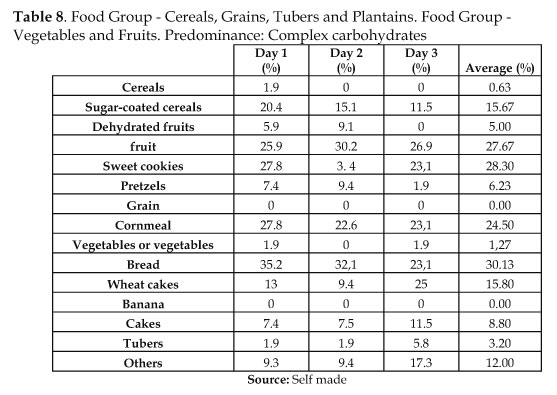
Analysis: Based on the information shown in Graph 2, we can see that children brought in their lunchboxes foods comprised mainly of bread, referring to white, brown, quill and sandwich; then, to a lesser extent appeared sweet biscuits, with Mary-type standing out, butter cookies with chocolate chips and chocolate chip cookies. Following these were fruits such as pineapple, tangerine, apple, peach and pin. Similarly, it is evident the intake of corn flour, mainly with cornmeal roll; wheat cakes, as cheese pancakes and pastries, as well as sugary cereals, including frosted flakes, yogurt with cereal, chocolate and sugary pads rings. Among other carbohydrates present in the lunchboxes of children were pancakes, syrup and accompanying sauces such as tomato sauce. In small amounts, we observed the presence of tubers, cakes, crackers, vegetables, dried fruits and unsweetened cereal. On the other hand, we noted the absence of beans and bananas. It is worth mentioning the significant increase in cakes on the third day of scan; however, since a similar amount is maintained in the other two observations, we could infer that, on that day, there had occurred atypical issues in family dynamics that might have led to this increase.
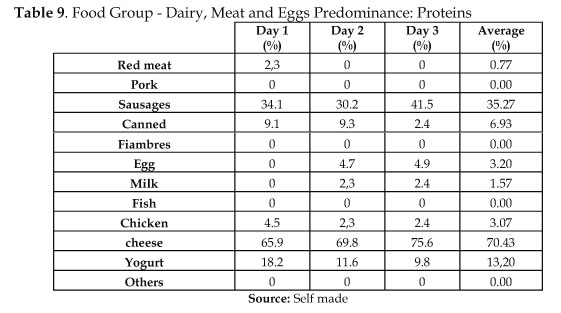
Analysis: According to the information shown in Graph 1, we can see that children carried in their lunchboxes food predominantly containing cheese that could be yellow, white, goat and spreadable, then, to a lesser extent, there appeared sausages such as pork leg ham and turkey breast. Also, it is evident, as far as recurrence is concerned, the intake of yogurt and canned ham. A small number of students had chicken, red meat and liquid milk. No fish, pork or deli meats such as bologna and mortadella were observed. There is a remarkable increase in cold meats in the second observation; however, since there is a similar amount in the other two observations, we be infer that, on that day, there had occurred atypical issues in family dynamics that could have led to this increase.
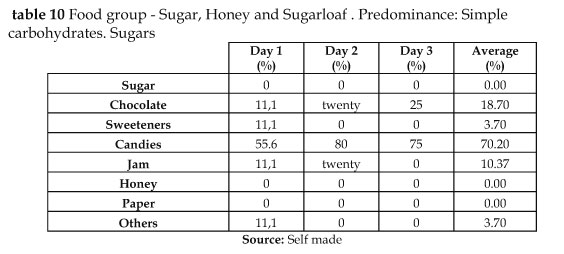
Analysis: Taking into account the information shown in Graph 3, it is possible to note that, among the predominant sugars there were sweets, mainly candies, gummies and milk chocolate bars. Following the above, we observed chocolate with a higher percentage of 58.5% cocoa, not seen as a sweet. Then, to a lesser extent, marmalade accompanying sandwiches and sweeteners in the case of a few students, especially in flavored waters. We observed no sugar as a supplement to their meals like honey and sugarloaf.
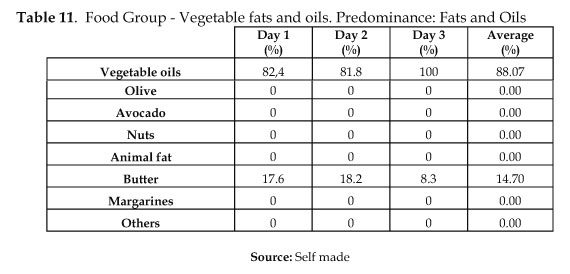
Analysis: According to the information shown in Graph 3, we can see that, in the group of fats, vegetable oils stood out, referring to fried cornmeal rolls and fried pies. Then, to a lesser extent, there was butter accompanying both sandwiches and cornmeal rolls and, finally, dried fruits such as raisins. On the other hand, we noted the absence of margarines, animal fat and avocado.
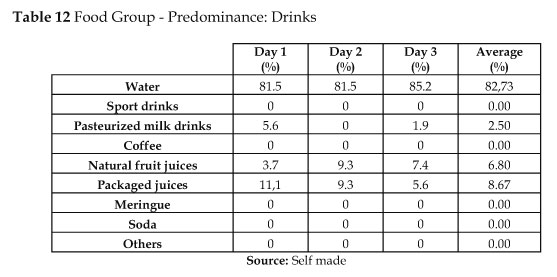
Analysis: Based on the information shown in Graph 5, one can see that children carried in their lunchboxes drinks that were predominantly composed of water, to a lesser extent, packaged juices and then the natural fruit juices. In a small number of students, we saw the presence of pasteurized milk drinks such as chicha or chocolate colored drinks. On the other hand, no coffee, soft drinks, sports drinks or milkshakes were observed.
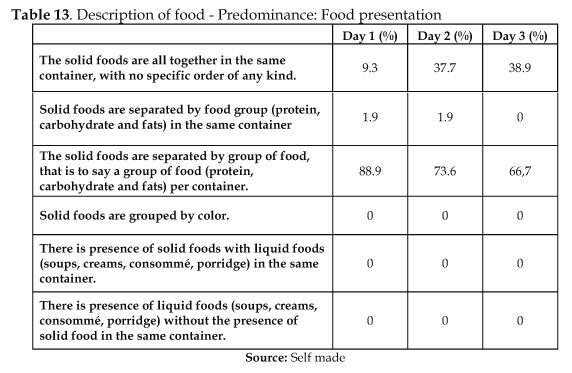
Analysis: Taking as reference the information shown in Graph 6, it is possible to observe two types of food presentations in the lunchboxes of children; primarily solid foods are separated by food group, ie fruits, sandwich and dried fruits were each in a different container. Then, we noted that solid foods are all together in the same container, in no particular order of any kind, such as corn-based pancake with cheese and pancake with cheese. In a small number of students, we could see that the solid food was separated by food group in the same container. Moreover, we did not observe that the solid food was grouped by color, presence of solid food with liquid food (soups, creams, consomme, slurry) in the same container and presence of exclusive liquid food.
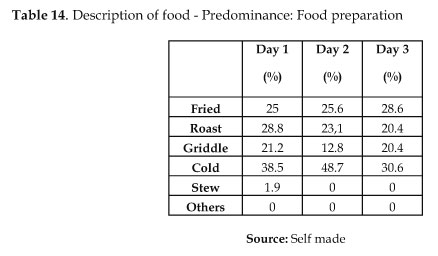
Analysis: Making reference to the information shown in Graph 8, we may note that children carried in their lunchboxes food that was predominantly cold, such as: sandwiches. To a lesser extent, there was food the preparation of which was based on frying, nuggets, cheese pancakes and pies; then roasted food, mainly cheese pancakes. In a small number of students, we saw grilled food such as pancake and corn-based pancake. No food the preparation of which will be based on the stew was observed.
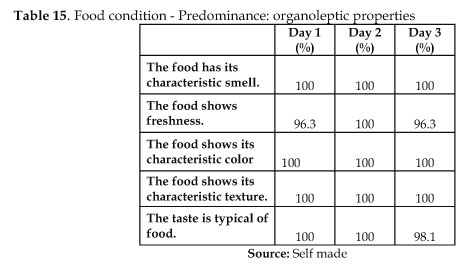
Analysis: According to the information shown in Graph 9, it is possible to note that children brought in their lunchboxes food that predominantly had its characteristic odor, color and texture. Then the taste of food was typical and, to a lesser extent, food that compromised its freshness such as pizzas and croissants.
4.3. Analysis of the results of the scan of the diet consumed by children aged 3 to 6 years not enrolled in the food service and the balanced diet a preschooler should consume according to INN
Based on the data and information we obtained, we proceed to describe the diet consumed by children aged 3 to 6 years not enrolled in the food service and the parameters set by INN for a balanced diet. Food grouping shown here is based on the Food Spinning Top (INN) and Tables 1, 2, 3, 4, 5 and 6.
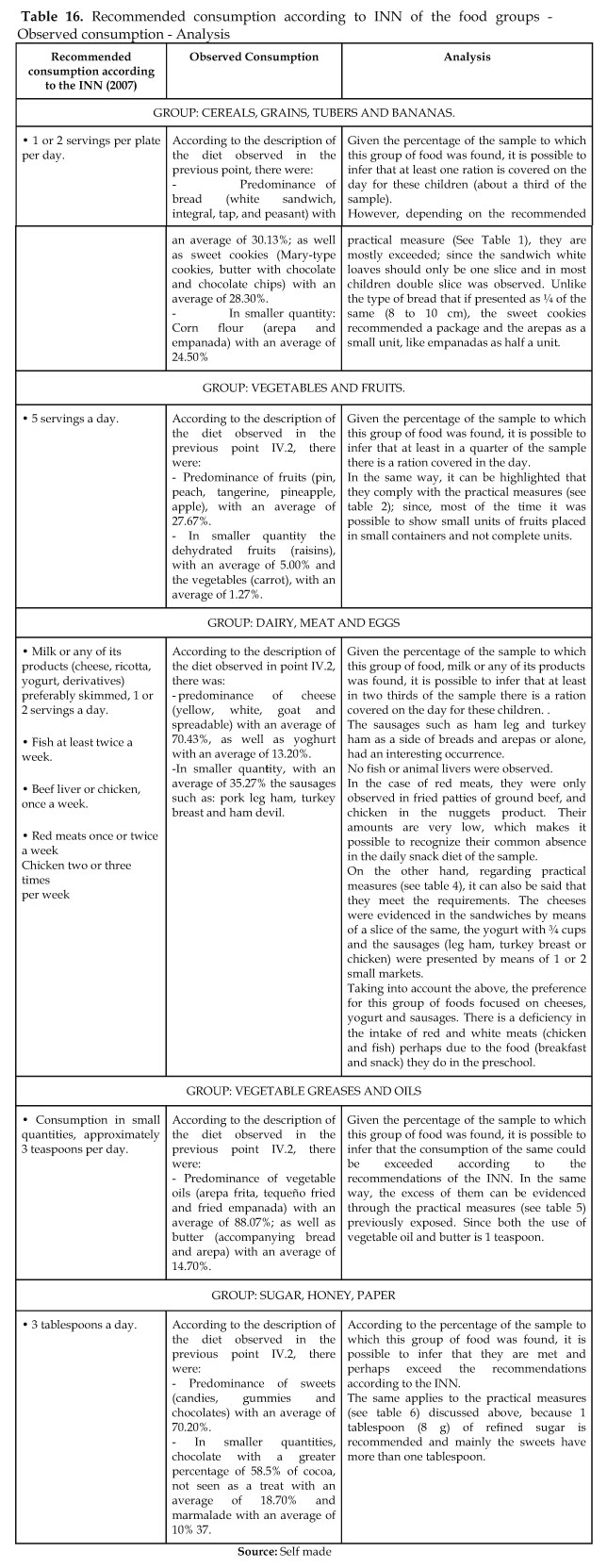
5. CONCLUSIONS
After conducting the scan in order to know the diet consumed by children aged 3 to 6 years not enrolled in the food service and describe the diet consumed by children aged 3 to 6 years not enrolled in the food service so as to, finally, analyze these results based on the diet a preschooler should consume according to the National Institute of Nutrition (NIN) and compare them with the results found through our scan , it is possible to conclude the following:
In general, it was observed that most children regularly consume everything they are sent in their lunchbox, otherwise classroom teachers push students to consume all the food they bring; if students fail to do so, their teachers will strive to have students consume at least half of the portion of food. Usually, first they eat the sandwich, cornmeal roll, cheese pancake, pancakes or any food made of corn or wheat flour. Then, if they have fruits, they go on eating this food and, finally, they eat the candy, cookies or sweets. We frequently observed that the food portions children carried were abundant in relation to the requirements proposed by INN and the practical measures (see Table 1), especially as regards sandwiches.
As for the content of lunchboxes and food groups present therein, the three most predominant groups were: “Vegetable oils and fats”, “Dairy, Meat and Eggs” and “Sugar, Honey, Sugarloaf”. In the group “Vegetable fats and oils” there was predominance of vegetable oils with 88.07%; with an outstanding role played by those used to fry food such as fried cornmeal roll, fried cheese pancake, fried pie and nuggets made of fried chicken. Then, in the group of “dairy, meat and eggs”, with an average of 70.43%, cheese (yellow, white, goat spreadable). Finally, the group of “sugar, honey, sugarloaf” with predominance of sweets such as candies, gummies and chocolates, with an average of 70.20%.
From these results and based on the parameters set by the National Institute of Nutrition, we can recognize that, from the Group of Cereals, Grains, Tubers and Plantains; at least there is a covered ration on the day for these children (the third part of the sample approximately). In the Group of Vegetables and Fruits, we can also recognize that, at least in a quarter of the sample, there is a covered ration on the day. Then, in the Group of Dairy, Meat and Eggs, we can note that, at least in two thirds of the sample, there is a covered ration on the day for these children.
Making reference to both the Group Vegetable Fats and Oils and the Group Sugar, Honey, Sugarloaf, it is possible to conclude that their consumption could be exceeded according to the recommendations of INN. There is a marked trend towards consuming fried food as compared to cold, roasted, broiled, grilled or stewed food, and towards the intake of sweets such as candy and gummies as compared to fruits. Both findings could move away from what is healthy given their recurrence and abundance.
Based on these findings, we propose the design of a guide for healthy lunchboxes, said guide targeting parents, caregivers and teachers who somehow have contact with children in their school dynamics , showing how to “assemble” the lunchbox using food groups in adequate and balanced amounts, following the theoretical and practical recommendations previously addressed in the previous sections. Similarly, the importance of contributing not only to the design of a snack or breakfast but to all feeding routines is highlighted.
REFERENCES
1. Barone V, Suarez I (2003). Educación para la salud. Venezuela, Caracas.
2. Barría P, Mauricio R, Amigo-C Hugo (2006). Transición Nutricional: una revisión del perfil latinoamericano. Archivos Latinoamericanos de Nutrición, 56(1):03-11. Recuperado de: http://www.scielo.org.ve/scielo.php?script=sci_arttext&pid=S0004-06222006000100002&lng=es&tlng=es.
3. Campbell D, Stanley J (1978, 2º reimpresión). Diseños Experimentales y Cuasi experimentales en la investigación social. Buenos Aires: Amorrortu editores.
4. Danielle E (2006). Obesidad Infantil. Argentina, Buenos Aires.
5. Fayard M (1956). Salud y Vigor por la alimentación. Estados Unidos, Illinois.
6. Fishbein M (1967). Enciclopedia Familiar de la Medicina y la Salud. Estados Unidos: Nueva York.
7. García-Narváez ME, Dini-Golding E (2009). Alimentación en el lactante. En: Henríquez-Pérez G, Dini-Golding E. Nutrición en pediatría. (pp. 265-293). Caracas: Centro de Atención Nutricional Infantil de Antímano.
8. Gerrig J, Zimbardo P. (2005). Psicología y Vida. Nueva York, Estados Unidos.
9. Gispert C (1983). Cursos de Orientación Familiar. Desarrollo del niño. España, Barcelona.
10. Gispert C (1983). Cursos de Orientación Familiar. Medicina y Salud. España, Barcelona.
11. Hassink S (2007). Obesidad Infantil. España, Madrid.
12. Henríquez G, Golding E (2009). Nutrición en pediatría, Tomo 1. Venezuela, Caracas.
13. Henríquez G, Dini E (2009). Nutrición en Pediatría. Venezuela, Caracas.
14. Hernández R, Fernández C, Baptista P (2006). Metodología de la Investigación. México DF.
15. Instituto Nacional de Nutrición (1982). La alimentación del niño desde su nacimiento hasta la adolescencia. Venezuela, Caracas.
16. Instituto Nacional de Nutrición (2014). Nosotros. Venezuela, Caracas. Recuperado de: http://www.inn.gob.ve/innw/?page_id=496
17. Instituto Nacional de Nutrición (sf). Crece el Índice de obesidad en Venezuela. Venezuela, Caracas. Recuperado de: http://www.inn.gob.ve/modules.php?name=News&file=article&sid=1170
18. Kleseges RC, et al (1993). Pediatrics 91(2):281-286.
19. Kliskber B (2000). América Latina: una región en riesgo, pobreza, inequidad e institucionalidad social. Washington DC.
20. Landaeta M (2000). Anales Venezolanos de Nutrición, 13(2):94-100.
21. Landeau R (2007). Elaboración de Trabajos de Investigación. Venezuela, Caracas.
22. Ley Orgánica de Educación (2009). Venezuela, Caracas.
23. Ley Orgánica para la Protección de niños, niñas y adolescentes. (2012). Venezuela.
24. Mahan L, Escott-Stump S (2009). En Krause Dietoterapia. España, Barcelona.
25. McMurry J (1992). Química orgánica. Estados Unidos.
26. Meece J (2000). Desarrollo del niño y del adolescente. Para educadores. México: Mc. Graw-Hill.
27. Montero C (2003). Alimentación y Vida Saludable. España, Madrid.
28. Organización de las Naciones Unidas para la Agricultura y la Alimentación (1997). Los carbohidratos en la Nutrición Humana. Italia, Roma.
29. Organización Mundial de la Salud. (2015 Enero). Obesidad y Sobrepeso. Suiza: Ginebra. Recuperado de http://www.who.int/mediacentre/factsheets/fs311/es/
30. Osorio C, Di-Luca M (2014). Perfil Nutricional Venezuela 2013-2014. Venezuela: Caracas. Recuperado de http://www.inn.gob.ve/innw/wp-content/uploads/2015/06/Perfil-Alimentario-y-Nutricional-2013-2014.pdf
31. Perdomo L, Mendoza C (2006). Sobrepeso y Obesidad en Venezuela (Prevalencia y factores condicionantes). Venezuela, Caracas.
32. Pérez V (2013). Informe Gestión CANIA 2012-2013. Caracas, Venezuela.
33. Posada A, Gómez J, Ramírez H (2005). El niño sano. Colombia, Bogotá.
34. RAE (2015). Real Academia Española.
35. Reinosa C, Carvajal M (2009). Universidad Central de Venezuela. Facultad de Medicina. Escuela de Nutrición y Dietética. Venezuela: Caracas.
36. Toro ID, Parra RD (2006). Método y Conocimiento. Metodología de la Investigación. Colombia, Medellín.
37. Tojo R, Leis R, Grupo de Trabajo de la Obesidad en Niños de la Estrategia NAOS. (2007). La Obesidad en Niños y Adolescentes. En: Nutrición y Actividad Física y Prevención de la Obesidad (pp. 69-112). Madrid: Estrategia NAOS. Médica Panamericana Ed.
38. UNESCO (2016). Órganos rectores de la Unesco. Francia: Paris. Recuperado de: http://www.unesco.org/new/es/unesco/about-us/who-we-are/governing-bodies/
39. Universidad Metropolitana (2013). CENDIF. Venezuela: Caracas. Recuperado de: http://www.unimet.edu.ve/mision-vision-y-valores/
40. Vázquez C, De-Cos A, López-Nomdedeu C (2005). Alimentación y nutrición. España.